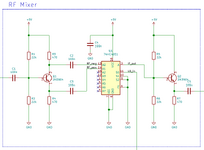neazoi
Advanced Member level 6

Is this switching mixer considered a double balanced mixer?
The local oscillator in my case is very low, 3KHz and the RF input is 10MHz.
My goal is, the output of the mixer, not to contain the actual RF input signal (10MHz), but only the rest products of mixing.
Please advise me if this is the case with this mixer.
The local oscillator in my case is very low, 3KHz and the RF input is 10MHz.
My goal is, the output of the mixer, not to contain the actual RF input signal (10MHz), but only the rest products of mixing.
Please advise me if this is the case with this mixer.

